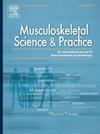“我觉得我的身体有些不对劲”:患有髋关节/腹股沟疼痛的积极活动的成年人对髋关节肌痛的信念和态度-一项定性研究。
IF 2.2
3区 医学
Q1 REHABILITATION
引用次数: 0
摘要
背景:髋关节肌酐是髋关节/腹股沟疼痛的成人活动患者的一种持续性和高度普遍的症状。它的存在可能会影响他们对预后、治疗选择和体育参与的看法。目的:探讨患有髋关节/腹股沟疼痛的成人活动期患者对髋关节肌酐的看法和态度。方法:对15名定期参加体育活动的髋关节/腹股沟疼痛成人进行半结构化访谈。在协商一致会议之前,两位作者通过六阶段反身性专题分析,对访谈的逐字逐句进行了独立分析。结果:我们确定了一个总体主题:Crepitus -一种不想要的感觉,根据他们对Crepitus和相关症状的描述,将样本分为两组:(i)咔哒声和紧绷,(ii)磨碎和疼痛。两组之间的异同主要体现在三个主题上:(1)与信用有关的担忧——不确定和焦虑;(2)肌酐对运动和日常生活的影响-避免髋关节屈曲;(3)不同的治疗思维——坚持前进。结论:我们的研究结果提供了关于髋关节/腹股沟疼痛的活跃成人对髋关节肌痛的看法的新信息,为卫生专业人员提供了对患者看法的见解。综上所述,患有髋关节/腹股沟疼痛的积极活动的成年人,由于髋关节crepitus的感觉,改变了他们的活动,特别是髋关节屈曲运动。此外,他们通常担心他们的crepitus的意义和他们的髋关节健康的未来,并对积极治疗感兴趣,以减少髋关节crepitus的严重程度。本文章由计算机程序翻译,如有差异,请以英文原文为准。
“I think there is something not right in my body”: Beliefs and attitudes of active adults with hip/groin pain towards hip crepitus – A qualitative study
Background
Hip crepitus is a persistent and highly prevalent symptom in active adults with hip/groin pain. Its presence may influence their perceptions about prognosis, treatment options and sports participation.
Objective
We explored the beliefs and attitudes of active adults with hip/groin pain towards hip crepitus.
Methods
Semi-structured interviews involving 15 adults with hip/groin pain who participated regularly in sports activities were conducted. Verbatim transcriptions of the interviews were independently analysed through a six-phase reflexive thematic analysis by two authors prior to the consensus meetings.
Results
We identified one overarching theme: Crepitus – an unwanted sensation, which divided the sample into two groups based on their description of crepitus and associated symptoms: (i) clicking and tightness and (ii) grinding and pain. The similarities and differences between the two groups were highlighted for the three main themes: (1) Worries related to crepitus – uncertainty and anxiety; (2) Impact of crepitus on sport and daily life – hip flexion avoidance; and (3) Different mindsets about crepitus treatment – keep on moving.
Conclusion
Our findings provide novel information regarding the perspectives of active adults with hip/groin pain towards hip crepitus, generating insights for health professionals on patients’ perceptions. In summary, active adults with hip/groin pain modify their activities, especially hip flexion movements, due to the sensation of hip crepitus. Additionally, they are typically worried about the meaning of their crepitus and the future of their hip joint health and are interested in active treatments to reduce the severity of hip crepitus.
求助全文
通过发布文献求助,成功后即可免费获取论文全文。
去求助
来源期刊

Musculoskeletal Science and Practice
Health Professions-Physical Therapy, Sports Therapy and Rehabilitation
CiteScore
4.10
自引率
8.70%
发文量
152
审稿时长
48 days
期刊介绍:
Musculoskeletal Science & Practice, international journal of musculoskeletal physiotherapy, is a peer-reviewed international journal (previously Manual Therapy), publishing high quality original research, review and Masterclass articles that contribute to improving the clinical understanding of appropriate care processes for musculoskeletal disorders. The journal publishes articles that influence or add to the body of evidence on diagnostic and therapeutic processes, patient centered care, guidelines for musculoskeletal therapeutics and theoretical models that support developments in assessment, diagnosis, clinical reasoning and interventions.
 求助内容:
求助内容: 应助结果提醒方式:
应助结果提醒方式:


